Four particles, each of mass 1kg, are placed at the corners of a square OABC of side 1m. 'O' is at the origin of the coordinate system. OA and OC are aligned along positive x-axis and positive y-axis respectively. The position vector of the centre of mass is (in 'm')
ˆi+ˆj
12(ˆi+ˆj)
(ˆi−ˆj)
12(ˆi−ˆj)
The correct Answer is:B
To find the position vector of the center of mass of the four particles placed at the corners of a square, we can follow these steps:
Step 1: Identify the coordinates of the particles
The square OABC has its corners at the following coordinates:
- O (0, 0)
- A (1, 0)
- B (1, 1)
- C (0, 1)
Step 2: Assign masses to the particles
Each particle has a mass of 1 kg. Therefore, the total mass M of the system is:
M=1kg+1kg+1kg+1kg=4kg
Step 3: Calculate the x-coordinate of the center of mass
The x-coordinate of the center of mass xcm is given by the formula:
xcm=m1x1+m2x2+m3x3+m4x4M
Substituting the values:
xcm=1⋅0+1⋅1+1⋅1+1⋅04=0+1+1+04=24=12
Step 4: Calculate the y-coordinate of the center of mass
The y-coordinate of the center of mass ycm is given by the formula:
ycm=m1y1+m2y2+m3y3+m4y4M
Substituting the values:
ycm=1⋅0+1⋅0+1⋅1+1⋅14=0+0+1+14=24=12
Step 5: Write the position vector of the center of mass
The position vector of the center of mass can be expressed in vector form as:
→rcm=xcm^i+ycm^j=12^i+12^j
Final Answer
The position vector of the center of mass is:
→rcm=12^i+12^jm
---
The square OABC has its corners at the following coordinates:
- O (0, 0)
- A (1, 0)
- B (1, 1)
- C (0, 1)
Each particle has a mass of 1 kg. Therefore, the total mass M of the system is:
M=1kg+1kg+1kg+1kg=4kg
The x-coordinate of the center of mass xcm is given by the formula:
xcm=m1x1+m2x2+m3x3+m4x4M
Substituting the values:
xcm=1⋅0+1⋅1+1⋅1+1⋅04=0+1+1+04=24=12
The y-coordinate of the center of mass ycm is given by the formula:
ycm=m1y1+m2y2+m3y3+m4y4M
Substituting the values:
ycm=1⋅0+1⋅0+1⋅1+1⋅14=0+0+1+14=24=12
The position vector of the center of mass can be expressed in vector form as:
→rcm=xcm^i+ycm^j=12^i+12^j
The position vector of the center of mass is:
→rcm=12^i+12^jm
Similar Questions
Four particles of masses m,2m,3m,4m are placed at corners of a square of side 'a' as shown in fig. Find out coordinateds of centre of mass.
View SolutionThree particle each of 1 kg mass are placed at corners of a right angled triangle AOB, 'O' being the origin of coordinate system (OA and OB along the x-direction and +ve y-direction). If OA = OB = 1m, the position vector of centre of mass (in metres) is
View Solution
Knowledge Check
Four particles each of mass m are placed at the vertices of a square of side l. the potential at the centre of square is
A−√2Gm2l(2−1√2)B−2Gm2l(2+1√2)C−√2Gm2l(√2−1√2)D−2Gm2l(√2−1√2)
Four equal masses (each of mass M) are placed at the corners of a square of side a. The escape velocity of a body from the centre O of the square is
View SolutionFind the potential energy of 4-particles, each of mass 1 kg placed at the four vertices of a square of side length 1 m.
View SolutionThe moment of inertia of a system of four rods, each of length l and mass m, about the axis shown is:

View SolutionFour particle of mass m each are placed at four corners of a square ABCD of side a. Point O is the centre of the square. Moment of inertia of all four particles about an axis passing through
View SolutionFour point masses are placed at the corners of a square of side 2 m as shown in the figure. Find the centre of mass of the system w.r.t. the centre of square.

View SolutionFour particles of masses 1kg, 2kg, 3kg and 4kg are placed at the four vertices A, B, C and D of a square of side 1m. Find the position of centre of mass of the particles.
View SolutionTwo bodies of mass 2 kg and 5 kg have position (1 m, 2 m, 1 m) and (3 m, 2 m, -1 m) respectively. The position vector of centre of mass is
View Solution
